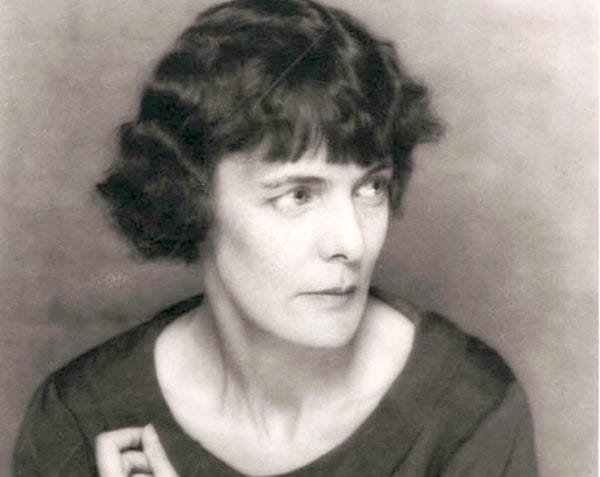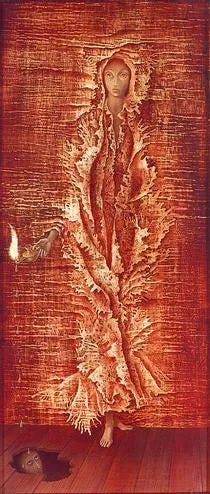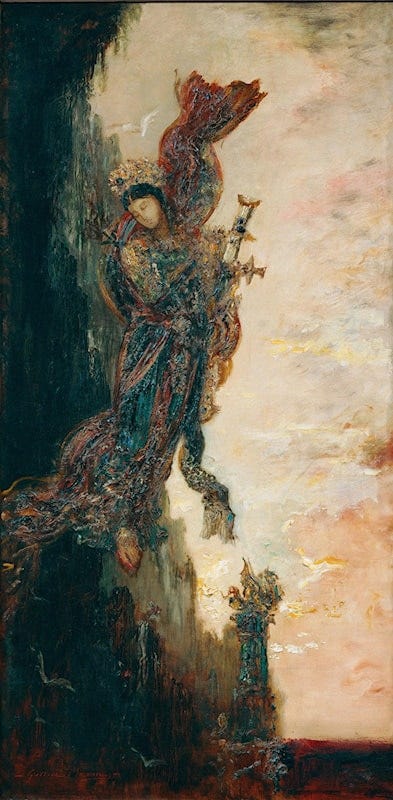The American Sybil
H.D.
This began as a reflection for the conclusion of a large salon on the topic of ‘Wyrd America’. I have revised and expanded it here as I woke up this morning with an uncontrollable need to praise H.D. I suspect I will have this urge many more times in the future.
Hilda Dolittle (1886-1961) or H.D. is my favorite poet of the modernist and Imagist movements. Echoing Hildegard von Bingen’s title Sybil of the Rhine, I affectionately think of her as the Sybil of Bethlehem, Pennsylvania. Or in light of her incisive and productive theological imagination, perhaps we should, like Hildegard, assign her among the doctors of the Church. I am drawn to name her Doctrix Ecstatica (I don’t think Denys the Carthusian would mind sharing titles with her) after her poem “Epitaph” which can be read on her tombstone–
So I may say,
“I died of living,
having lived one hour”;
So they may say,
“she died soliciting
illicit fervour,”
So you may say,
“Greek flower; Greek ecstasy
reclaims for ever
one who died
following
intricate song’s lost measure.”
For Ezra Pound and T.S. Eliot, H.D. was the poet of Imagism. She dove deeply into ancient traditions of myth and drama and her elevation of Sappho and Euripides as models provided the weapons for the revolutionary aesthetics of modernism. Stark, arresting lines. She eschewed more obviously forms of versification and artifice as she groped for living powers of language and long-forgotten mythemes, like perfect coral-shells abandoned on the ocean floor. These retrievals were accomplished not merely through desire but with the assistance of her stupendous erudition (an erudition that I would provocatively suggest exceeded Pound and Eliot). She was intimately familiar with the Greek language and some of her first publications are translations of Sappho and Euripidean choruses (from Iphigenia in Aulis and Hippolytus). Her Helen in Egypt is as much a contest with Stesichorus and Eurpides as it is with her contemporaries. One early lyric which anticipates her life-long love affair with Greek mystery religions is her At Eleusis ( but please read every poem in the 1924 collection Heliodora):
What they did,
they did for Dionysos,
for ecstasy’s sake:
now take the basket,
think;
think of the moment you count
most foul in your life;
conjure it,
supplicate,
pray to it;
your face is bleak, you retract,
you dare not remember it:
stop;
it is too late.
the next stands by the altar step,
a child’s face yet not innocent,
it will prove adequate, but you,
I could have spelt your peril at the gate,
yet for your mind’s sake,
though you could not enter,
wait.
What they did,
they did for Dionysos,
for ecstasy’s sake:
Now take the basket basket—
(ah face in a dream,
did I not know your heart,
I would falter,
for each that fares onward
is my child;
ah can you wonder
that my hands shake,
that my knees tremble,
I, a mortal, set in the goddess’ place?)
She is an undisputed master of the lyric form (indebted to Sappho) though her relation to epic should not be discounted. Besides Helen in Egypt (which is a kind of epic) she produced a major trilogy which accomplishes, even if not in a strict sense, the aims, goals, and style of epic. In her biography of H.D. Psyche Reborn (1981), Susan Stanford describes the Trilogy as a “mythic system” which “is more religious than Williams or Pound, more esoteric than Eliot, and more syncretist than Yeats.” The incandescence of her three volumes The Walls Do Not Fall (1942), Tribute to the Angels (1944), and The Flowering of the Rod (1944) emerge from her own direct experience of war; she was in London during the Nazi bombings. And this gorgeous artifact of religious syncretism, psychoanalysis, and spiritual realism, while experienced in England, has uniquely American roots. While the bombings were taking place, she would take comfort by remembering and writing about her own unique spiritual roots in Bethlehem, Pennsylvania.
Her hometown was home to a serious community of Moravian Brethren, a religious community descended from the early Hussites but inflected by the influence of Lutheran Pietism and mysticism through Count Nicholas von Zinzendorf. In fact, Zinzendorf was personally responsible for founding Bethlehem, Pennsylvania. Both Hilda’s mother and grandmother were deeply involved in Moravian spirituality and practice. H.D. was born and buried there. So while the bombs were going off around her, she writes in her memoirs:
“Now, this minute, the flying-bomb is
on the way—now this minute, there is a dis-
tant crash and we are safe for this minute...
Comfort and peace came to me, in recalling
the strange mystical adventures of Count
Zinzendorf and in a later chapter... the spir-
itual or psychic sub-strata of the religious in-
heritance of the race [Moravians].”
She was particularly interested in her grandmother’s transmission of some uniquely Moravian beliefs of the feminine identity of human souls and the person of the Holy Spirit. All of this, along with her own experiences of bisexual desire, focused her art on the seemingly endless paths and connections of feminine imagery in religious history. She brought this search together with her poetic task–we must each become a New Eve. It made her religious retrievals, in my mind, superior to the endemic misogyny of D.H. Lawrence’s mythopoesis (whom H.D. nevertheless admired and had affection for throughout their fraught relationship). Her religious background made her more sensitive to aspects of theological history lost to the androcentic blinders of Pound or Eliot (with the possible exception of Yeats). We see a good example of this in poem [38] from Tribute to the Angels:
O yes–you understand, I say,
this is all most satisfactory,
but she wasn’t hieratic, she wasn’t frozen,
she wasn’t very tall;
she is the Vestal
from the days of Numa,
she carries over the cult
Of the Bona Dea
she carries a book but it is not
the tome of the ancient wisdom
the pages, I imagine, are the blank pages
of the unwritten volume of the new
all you say, is implicit,
all that and much more;
but she is not shut up in a cave
like a Sibyl; she is not
imprisoned in leaden bars
in a coloured window;
she is Psyche, the butterfly,
out of the cocoon.
This newness, of course, also seeks to make sense of all that came before it. And this is in turn a distinctively American process, a variegated inheritance (at once ancient, medieval, and modern) overlaid on the astonishingly new. Bethlehem, Pennsylvania. H.D.’s relationship to her home was colored by disappointment at a later closure of theological and cultural freedom compared to her own early life and experience:
“I have felt all along a
deep gratitude for the place of my birth and
for my people—but my people, as I have
tried to show are not parochial, not condi-
tioned by small boundaries, not shut-in by
provincial barriers”
I find myself growing more and more attached to these words these days. We must also guard against love of place and roots blinding and asphyxiating us. Instead. like H.D., our metaphysical horizons should inspire a cosmopolitan search for what is truly human and truly divine in all things and peoples.
Another haunted and homeless poet, Denise Levertov, can give us the final word on H.D. and the way in which, I hope, the cipher of her life stands in for our own aspirations as members of religious communities in the modern world:
“She showed a way to penetrate mystery; which means, not to flood darkness with light so that darkness is destroyed, but to enter into darkness, mystery, so that it is experienced. And by darkness I don’t mean evil; not evil but the Other Side, the Hiddenness before which man must shed his arrogance; Sea out of which the first creeping thing and Aphrodite emerge; Cosmos in which the little speck of the earth whirls and in the earth ‘the dandelion seed’.”




Really love the thought about rootedness not needing to mean closedmindedness.
This is great!! Thanks so much for writing this 😁🙂